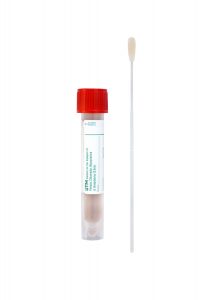Test Name
HSV 1 & 2 / VZV Amplification – Herpes Simplex Virus and Varicella-Zoster Virus, Molecular Detection (HSVVZV)
CPT Codes
87529 – QTY (2)
87798
Methodology
Probe Amplification
Turnaround Time
0 – 3 days
Specimen Requirements
Type:
Swab
Source:
Genital Lesions (penis; vaginal/cervical)
Skin Lesions
Nares Lesions
Ocular Lesions
Oral Lesions
Specimen Container:
Universal Transport Media (UTM): Regular-Tipped Flocked Swab
Stability
Ambient:
48 hours (up to 30°C)
Refrigerated:
7 days (2 – 8°C)
Frozen:
7 days (-20°C)
Additional Information
Background Information
Herpes simplex viruses (HSV) (Types 1 and 2) and Varicella-Zoster virus (VZV) are important causes of vesicular lesions. In many instances, laboratory testing is not needed to prove the presence of the virus; for example, if a patient presents with shingles in a classic dermatomal distribution, then the diagnosis is made based on the clinical findings, and laboratory testing for VZV is not needed. However, in other instances, laboratory testing is essential to demonstrate the presence of the virus (e.g., low-level viral shedding from a mucous membrane-associated lesion). Laboratory studies are also important for differentiation of HSV and VZV when the clinical presentation is not characteristic (e.g. shingles in the genital region).
Clinical Indications
The Symptomatic Patient: This test should be ordered when the cause of vesicular or similar lesion is uncertain.
The Asymptomatic Patient: Asymptomatic vaginal shedding of HSV is a risk factor for the baby during delivery. This test is warranted in pregnant women who are near delivery if there is a concern for the possibility of HSV shedding.
Interpretation
Qualitative test results (i.e. Positive or Negative for HSV1, HSV2, or VZV) will be reported.
Methodology
The Solana HSV 1+2/ VZV Assay is an FDA-approved isothermal amplification assay that detects and differentiates HSV1, HSV2, and VZV. Clinical studies performed at Cleveland Clinic (manuscript in preparation) have demonstrated a 94.7% sensitivity and 100% specificity for the detection of HSV with this assay. The formerly-employed assay (i.e. HSV ELVIS Test System) had a sensitivity and specificity of 71.1% and 93.2%, respectively.
Similarly, the detection of VZV with Solana was superior to direct immunofluorescence (DFA). The sensitivity/ specificity of the Solana assay for the detection of VZV in this study was 95.3%/100%, whereas for DFA these were 71.4%/100%, respectively.
Limitations
This test has limited sensitivity. In rare circumstances, false positives may occur if other intracytoplasmic inclusions are present; however, if the peripheral blood smear is negative, and these diseases are suspected, PCR testing and/or serologic studies are recommended to aid in diagnosis.
References
1. Faron M, Mashock M, Connolly J, Ledeboer N, Buchan B. Evaluation of the Solana HSV 1+2 assay for simultaneous detection of herpes simplex virus 1 and 2, and varicella zoster virus from cutaneous lesions. Session P091; P1894. 27th ECCMID. Vienna, Austria. 22-25 April 2017.
2. Granato PA, Degillo MA, Wilson EM. The unexpected detection of varicella-zoster in genital specimens using the Lyra™ Direct HSV1+2/VZV Assay. J Clin Virol 2016; Nov;84:87-89. doi: 10.1016/j.jcv.2016.10.007. Epub 2016 Oct 11.
3. Huppert JS, Batteiger BE, et al. Use of an Immunochromatographic Assay for Rapid Detection of Trichomonas vaginalis in Vaginal Specimens. Journal of Clinical Microbiology. 2005; 684-687.
4. Solana HSV 1+2/VZV Assay product information and package insert, Quidel, San Diego, CA 92130.

